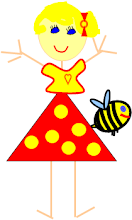Give your preschoolers opportunities to develop their cutting skills but before you do so consider a few of the following suggestions:
- Make sure scissors will actually cut. If you can't cut a piece of paper with the child-sized scissors you select then chances are, your preschoolers wont be able to either.
- Have left and right handed scissors available.
- Teach your preschoolers how to hold the scissors correctly and how to open and close the scissor handles.
- Teach your preschoolers how to hold the paper with the other hand so that he or she can cut more easily.
- Keep an eye on preschoolers when they are using scissors and make sure they are sitting down at a table.
- Teach your preschoolers good safety practices so they will respect scissors and use them for cutting paper, not hair, clothes, or each other!
Let preschoolers cut scraps of paper
Set out some old newspapers or left over scraps of paper and just let students cut. Preschoolers need time to build their fine motor skills and this is a terrific way to encourage cutting practice.
Let preschoolers cut playdough
Set out some playdough and scissors and let students work on their cutting skills this way as well.
Work on snipping before cutting on the lines
To begin more formal cutting activities, have preschoolers start by snipping around the edges of a piece of paper. Snipping helps preschooler work on their fine motor control as well as eye-hand coordination.
Be selective in choosing cutting materials
Some materials such as fabric and tissue paper are difficult for adults to cut, yet alone preschoolers. While preschoolers are developing their ability to cut, select materials that will help them have a successful experience rather than a frustrating experience.
For very young preschoolers
Have them start with tearing paper but just like cutting, make sure the paper is something they can actually tear. Tissue paper is nice for tearing. Tearing helps to build those small muscles needed for cutting later on.
Be selective in choosing cutting activities.
Gradually build towards more complex cutting activities and be sensitive to the skills and abilities of each preschooler in your care. The following chart is a suggestion for developing cutting skills.




5 comments:
For more suggestions, visit www.ProductiveParenting.com which provides you with a simple, daily activity based on the age of your child. The activities range from simple sensory experiences and progress to more challenging activities- and the site is free!
Haha, I agree about the importance of allowing them to use scissors that actually cut.
I find those child safety scissors to be such a pain too!
Regards
Mark
http://earlychildcare.wordpress.com/
You got it! If the scissors don't cut, then cutting can be a very frustrating skill to develop :)
And for the children who have trouble with cutting for lack of strength, have them begin with a hole puncher to build up the muscles they will need for cutting with a scissor.
Linette
http://ReachOurYouth.com
I learn something new of teaching scissor skills.
Provide beginners with tiny oval handles with short blades scissors. This ease the frustrating of cutting. pg. 54
A small object such as a penny, sponge or cotton ball can then be placed in the palm of the hand to assist the child in correct finger position. pg. 54
P.E.A.R.L.
Providing for Early At-Risk Learners
By: Susan W. owens
ISBN 0-9715528-0-0
Post a Comment